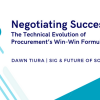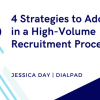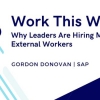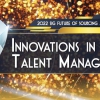Remote work is expected to be the biggest business change coming out of the COVID-19 pandemic, but not the only one. Organizations are faced with many new decisions to build and sustain the talent pipeline as they come back to work:
- What’s the right balance of contingent versus full-time staffing?
- Which markets are the best for us to source talent now that we aren’t constrained to specific office locations?
- Which open positions would be best staffed remotely versus on-site?
- Given the market has shifted and we have a larger candidate pool to source from, how do we maximize our time, and focus on the talent most likely to engage?
- How do we increase diversity in hiring and attract candidates from underrepresented communities?
Figuring out the answers to these questions is hard enough. Making these calls against a backdrop of pandemic-driven financial and economic uncertainty is even harder. But with the right data and insights, procurement and hiring teams can make these strategic decisions in a way that creates competitive advantage, contains costs and drives new value for their organizations.
Smarter Talent Location and Sourcing Decisions that Expand the Candidate Pool
HR and procurement leaders are playing critical roles in helping their organizations through the COVID-19 pandemic. Talent is arguably an organization’s biggest asset – and that especially rings true during difficult times when there’s extra pressure for results. But expanding the talent pool is only half the battle. During a crisis, organizations need to simultaneously control costs.
There are four main ways in which AI is enabling organizations to find the talent they need, at the right cost, and faster than the competition.
- Identify cost-effective talent hubs.
It’s easy to stick with what you know. Maybe you’ve always looked for software engineers in San Francisco because you know the quality of talent is high. Or, perhaps you gravitate to hiring your finance team out of Manhattan because there’s a surplus of ex-Wall Streeters ready to try something new.
While both cities are talent hubs for a reason, failing to explore other markets is a missed opportunity for your organization. With most of the working world now remote, the talent pool is significantly larger. There is plenty of high-quality finance and tech talent in other (less competitive and lower cost) markets gunning for a new opportunity – you just need to know where to look.
Based on a variety of inputs – job descriptions, employer-specific requirements, local commuting patterns, salary requirements, market-specific talent supply and demand gaps, and more – AI can recommend the best markets from which to source your role. Without this predictive insight, you might not have ever known that Pittsburgh is a rising hub for software engineering talent (with a 38% savings versus San Francisco) or that Dallas has an abundant supply of financial analysts (with a 31% savings versus New York).
- Know which jobs should go where.
A bad hiring decision is estimated to cost 30% of an employee’s first-year earnings. To avoid this risk, employers should take every step they can to vet and ensure their confidence in a candidate before they hire. But in our “now normal” of remote work, a smart hiring decision isn’t just about feeling good about the prospective employee’s skillsets and experience, but also about where they’re placed.
Employers now have several options for how to staff roles: onsite, fully remote or near remote (with access to an existing office location). Some roles still aren’t “remote ready” and require high levels of collaboration to get the job done.
Based on corporate culture, role requirements, and industry and similar role benchmarks, procurement leaders can leverage AI to uncover and determine the best way to staff specific roles before they make an offer. This minimizes the risk of placing someone in an arrangement where they, and by extension the rest of the team, won’t be successful, as well as subsequent replacement costs.
- Speed the talent acquisition process.
The average time to fill a position is 42 days. Imagine if your organization could figure out which candidates were the most receptive to exploring new job opportunities before they even applied to your opening?
AI is enabling procurement and recruiting teams to proactively identify candidates – both full-time and contingent – who are most likely to engage, enabling them to shortlist and prioritize the most promising talent. This speeds the hiring process and lowers talent acquisition costs by focusing time, energy and resources on those most likely to accept an offer.
You can snatch up talent before your competitors, and even identify which of their workers might be ready to leave. This provides you a powerful advantage in building and sustaining a high quality and reliable talent pipeline. In fact, an article in Harvard Business Review highlighted that candidates who were identified as most likely to engage by an AI-powered algorithm were twice as receptive to an unsolicited recruitment message, and 63% more likely to accept a new position versus prospects classified as least likely to engage.
- Build a bigger pipeline of diverse talent.
There’s a clear link between remote workforces and talent diversity. The ability to hire out of any market removes location bias and expands the pool of candidates with unique experiences, skills and ideas.
AI is playing a valuable role in helping employers cultivate inclusive recruiting practices. The algorithms identify candidates likely to have diverse backgrounds – gender, national origin, ethnicity, veterans and more – so organizations can find and prioritize talent with the right skillsets from underrepresented communities.
Companies in the top quartile for gender diversity on executive teams are 25% more likely to have above-average profitability. Building a diverse talent pipeline is becoming an even bigger business priority, and organizations that leverage predictive insights to foster inclusivity will be significantly further ahead.
Predictive Insights: A No-Brainer for Today’s Labor Market
We are in a period of unprecedented uncertainty, and procurement and hiring teams need to be agile, proactive and informed. AI is an invaluable asset because it can analyze data and help inform and make decisions much faster than humans can on their own.
Under pressure to deliver new value and cut costs, procurement teams that leverage predictive insights can help their organizations invest in the right workers with the right skillsets at the right time and cost, to successfully scale their workforce and navigate the evolving market dynamics.







